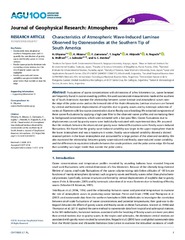Mostrar el registro sencillo del ítem
Characteristics of Atmospheric Wave-Induced Laminae Observed by Ozonesondes at the Southern Tip of South America
| dc.contributor.author | Ohyama, Hirofumi | |
| dc.contributor.author | Mizuno, Akira | |
| dc.contributor.author | Zamorano, Félix | |
| dc.contributor.author | Sugita, Takafumi | |
| dc.contributor.author | Akiyoshi, Hideharu | |
| dc.contributor.author | Noguchi, K. | |
| dc.contributor.author | Wolfram, Elián | |
| dc.contributor.author | Salvador, Jacobo | |
| dc.contributor.author | Carbajal Benítez, Gerardo | |
| dc.date.accessioned | 2019-08-05T12:33:19Z | |
| dc.date.available | 2019-08-05T12:33:19Z | |
| dc.date.issued | 2018-10-15 | |
| dc.identifier.citation | Ohyama, H., Mizuno, A., Zamorano, F., Sugita, T., Akiyoshi, H., Noguchi, K., et al. (2018). Characteristics of atmospheric wave-induced laminae observed by ozonesondes at the southern tip of South America. Journal of Geophysical Research: Atmospheres, 123. https://doi. org/10.1029/2018JD028707 | es |
| dc.identifier.issn | 2169-897X | |
| dc.identifier.uri | http://hdl.handle.net/20.500.12160/1124 | |
| dc.description | Artículo publicado en la Revista Journal of Geophysical Research: Atmospheres, No.123, p. 1-19, 2018. | es |
| dc.description.abstract | Fluctuations of ozone concentrations with dimensions of a few kilometers (i.e., ozone laminae) are frequently found in ozone-sounding profiles. We used ozonesonde measurements made at the southern tip of South America to examine the relationship between ozone laminae and atmospheric waves near the edge of the polar vortex and on the leeward side of the Andes Mountains. Laminar structures are formed by vertical and horizontal displacements of isopleths due to gravity waves and by isentropic advection of vortex air filaments with low ozone concentration due to Rossby wave breaking. We extracted components of these ozone fluctuations by applying a high-pass filter to the observed ozone profiles and normalizing them to background concentrations, which were extracted with a low-pass filter. Ozone fluctuations due to displacements caused by gravity waves were individually evaluated with experimental data. We assumed that the residuals between the observed and gravity wave-induced fluctuations were Rossby waves-induced fluctuations. We found that the gravity wave-induced variability was larger in the upper troposphere than in the lower stratosphere and was a maximum in winter. Rossby wave-induced variability showed a distinct seasonal pattern in the lower stratosphere and accounted for a large portion of the observed variability. We also examined the relationship between gravity wave-induced and Rossby wave-induced ozone variability and the differences in equivalent latitudes between the sonde positions and the polar vortex edge. We found that variability was larger inside than outside the polar vortex. | es |
| dc.language.iso | eng | es |
| dc.publisher | Journal of Geophysical Research: Atmospheres | es |
| dc.subject | OZONESONDE | es |
| dc.subject | OZONE LAMINAE | es |
| dc.subject | ATMOSPHERIC WAVES | es |
| dc.subject | GRAVITY WAVES | es |
| dc.title | Characteristics of Atmospheric Wave-Induced Laminae Observed by Ozonesondes at the Southern Tip of South America | es |
| dc.type | Artículo | es |
